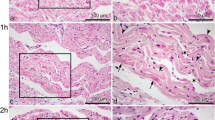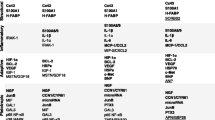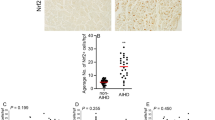Abstract
The goal of this study was to assess whether early markers of myocardial ischemia, identified in a previous experimental work, can be applied in forensic pathology cases of sudden, ischemic cardiac death. These markers include desphosphorylated connexin 43 (Cx43), JunB, TUNEL assay, myoglobin, and troponin T. Fourteen cases of sudden cardiac death with gross and/or histological signs of myocardial infarction and 14 cases of sudden cardiac death with signs of early ischemia at histology and positive immunoreactions for fibronectin and C5b-9 were investigated. The control group was represented by 15 hanging (global hypoxia) cases. Immunohistochemical reactions were classified into four degrees and compared among groups. Cx43 and JunB were significantly more expressed in hanging than in ischemia/infarction, but they showed a different distribution in the tissue (sub-endocardial in ischemia/infarction, diffuse in hanging) and a different intensity of the signal. TUNEL assay was significantly more expressed in the group of early ischemia than in myocardial infarction. Myoglobin and troponin T did not show any significantly different expression among the three groups. Depletion markers have a limited application in forensic cases, and this is mostly because positive (depleted) areas are difficult to distinguish from artifactually paler areas. Nuclear markers (JunB and TUNEL), on the other hand, require a well-trained eye and a high magnification in order to be distinguished. Cx43, JunB, and TUNEL assays were confirmed to be early, sensitive markers for myocardial ischemia. Nonetheless, they are not specific, as they are expressed in global hypoxia as well, but with a different tissular distribution.




Similar content being viewed by others
References
Sabatasso S, Mangin P, Fracasso T et al (2016) Early markers for myocardial ischemia and sudden cardiac death. Int J Legal Med 130(5):1265–1280
Campobasso CP, Dell’Erba AS, Addante A et al (2008) Sudden cardiac death and myocardial ischemia indicators: a comparative study of four immunohistochemical markers. Am J Forensic Med Pathol 29:154–161
Fracasso T, Karger B, Pfeiffer H et al (2010) Immunohistochemical identification of prevalent right ventricular ischemia causing right heart failure in cases of pulmonary fat embolism. Int J Legal Med 124:537–542
Fracasso T, Pfeiffer H, Sauerland C et al (2011) Morphological identification of right ventricular failure in cases of fatal pulmonary thromboembolism. Int J Legal Med 125:45–50
Haitao B, Ying Y, Jianye H et al (2013) Immunohistochemical detection of S100A1 in the postmortem diagnosis of acute myocardial infarction. Diagn Pathol 8:84
Willems I, Arends JW, Daemen M (1996) Tenascin and fibronectin expression in healing human myocardial scars. J Pathol 179:321–325
Ortmann C, Pfeiffer H, Brinkmann B (2000) A comparative study on the immunohistochemical detection of early myocardial damage. Int J Legal Med 113(4):215–220
Shekhonin BV, Guriev SB, Irgashev SB et al (1990) Immunofluorescent identification of fibronectin and fibrinogen/fibrin in experimental myocardial infarction. J Mol Cell Cardiol 22(5):533–541
Casscells W, Kimura H, Sanchez JA et al (1990) Immunohistochemical study of fibronectin in experimental myocardial infarction. Am J Pathol 137(4):801–810
Hu BJ, Chen YC, Zhu JZ (1996) Immunohistochemical study of fibronectin for postmortem diagnosis of early myocardial infarction. Forensic Sci Int 78(3):209–217
Hu BJ, Chen YC, Zhu JZ (2002) Study on the specificity of fibronectin for post-mortem diagnosis of early myocardial infarction. Med Sci Law 42(3):195–199
Piercecchi-Marti MD, Lepidi H, Leonetti G et al (2001) Immunostaining by complement C9: a tool for early diagnosis of myocardial infarction and application in forensic medicine. J Forensic Sci 46(2):328–334
Edston E, Kawa K (1995) Immunohistochemical detection of early myocardial infarction: an evaluation of antibodies against the terminal complement complex (C5b-9). Int J Legal Med 108(1):27–30
Schäfer H, Mathey D, Hugo F et al (1986) Deposition of the terminal C5b-9 complement complex in infarcted areas of human myocardium. J Immunol 137(6):1945–1949
Ortiz-Rey JA, Suarez-Penaranda JM, Da Silva EA et al (2002) Immunohistochemical detection of fibronectin and tenascin in incised human skin injuries. Forensic Sci Int 126(2):118–122
Knowlton AA, Connelly CM, Romo GM et al (1992) Rapid expression of fibronectin in the rabbit heart after myocardial infarction with and without reperfusion. J Clin Invest 89(4):1060–1068
Thomsen H, Schulz A, Bhakdi S (1990) Immunohistochemical C5b-9-complement complex demonstration in early stages of myocardial necroses using paraffin sections. Z Rechtsmed 103(3):199–206
Väkevä A, Morgan BP, Tikkanen I et al (1994) Time course of complement activation and inhibitor expression after ischemic injury of rat myocardium. Am J Pathol 144(6):1357–1368
Edston E, Gröntoft L, Johnsson J (2002) TUNEL: a useful screening method in sudden cardiac death. Int J Legal Med 116:22–26
Bardales RH, Hailey LS, Xie SS et al (1996) In situ apoptosis assay for the detection of early acute myocardial infarction. Am J Pathol 149(3):821–829
Jugdutt BI, Idikio HA (2005) Apoptosis and oncosis in acute coronary syndromes: assessment and implications. Mol Cell Biochem 270(1–2):177–200
Takemura G, Fujiwara H (2006) Morphological aspects of apoptosis in heart diseases. J Cell Mol Med 10(1):56–75
Piro FR, di Gioia CR, Gallo P et al (2000) Is apoptosis a diagnostic marker of acute myocardial infarction? Arch Pathol Lab Med 124:827–831
Abbate A, Melfi R, Patti G et al (2000) Apoptosis in recent myocardial infarction. Clin Ter 151:247–251
Rodríguez-Calvo MS, Tourret MN, Concheiro L et al (2001) Detection of apoptosis in ischemic heart: usefulness in the diagnosis of early myocardial injury. Am J Forensic Med Pathol 22:278–284
Nakatome M, Matoba R, Ogura Y et al (2002) Detection of cardiomyocyte apoptosis in forensic autopsy cases. Int J Legal Med 116:17–21
Matsushita T, Takamatsu T (1997) Ischaemia-induced temporal expression of connexin43 in rat heart. Virchows Arch 431:453–458
Hatanaka K, Kawata H, Toyofuku T et al (2004) Down-regulation of connexin43 in early myocardial ischemia and protective effect by ischemic preconditioning in rat hearts in vivo. Jpn Heart J 45:1007–1019
Shaulian E, Karin M (2002) AP-1 as a regulator of cell life and death. Nat Cell Biol 4(5):E131–E136
Harpster MH, Bandyopadhyay S, Thomas DP et al (2006) Earliest changes in the left ventricular transcriptome postmyocardial infarction. Mamm Genome 17:701–715
Vargas SO, Sampson BA, Schoen FJ (1999) Pathologic detection of early myocardial infarction: a critical review of the evolution and usefulness of modern techniques. Mod Pathol 12:635–645
Kavsak PA, MacRae AR, Newman AM et al (2007) Effects of contemporary troponin assay sensitivity on the utility of the early markers myoglobin and CKMB isoforms in evaluating patients with possible acute myocardial infarction. Clin Chem Acta 380(1–2):213–216
Brinkmann B, Sepulchre MA, Fechner G (1993) The application of selected histochemical and immunohistochemical markers and procedures to the diagnosis of early myocardial damage. Int J Legal Med 106(3):135–141
Leadbeatter S, Wawman HM, Jasani B (1989) Immunocytochemical diagnosis of early myocardial ischaemic/hypoxic damage. Forensic Sci Int 40(2):171–180
Collinson PO, Gaze DC (2007) Biomarkers of cardiovascular damage. Med Princ Pract 16(4):247–261
Author information
Authors and Affiliations
Corresponding author
Ethics declarations
Conflict of interest
The authors declare that they have no conflict of interest.
Rights and permissions
About this article
Cite this article
Sabatasso, S., Moretti, M., Mangin, P. et al. Early markers of myocardial ischemia: from the experimental model to forensic pathology cases of sudden cardiac death. Int J Legal Med 132, 197–203 (2018). https://doi.org/10.1007/s00414-017-1605-7
Received:
Accepted:
Published:
Issue Date:
DOI: https://doi.org/10.1007/s00414-017-1605-7




